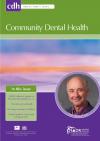Community Dental Health

- Cover Date:
- June 2016
- Print ISSN:
- 0265 539X
- Vol:
- 33
- Issue:
- 2
Overcoming structural inequalities in oral health: the role of dental curricula
L.A. Foster Page, V. Chen, B. Gibson and J. McMillan
Abstract: To date the role of health professional schools in addressing oral health inequalities have been minimal, as attempts have focused principally upon systemic reform and broader societal obligations. Professionalism is a broad competency that is taught throughout dental schools and encompasses a range of attributes. Professionalism as a competency draws some debate and appears to be a shifting phenomenon. We may ask if professionalism in the dental curricula may be better addressed by social accountability? Social accountability directs oral health professional curricula (education, research, and service activities) towards addressing the priority health concerns of the
community, in our case oral health inequalities. Although working toward dental schools becoming more socially accountable seems like a sensible way to address oral health inequalities, it might have limitations. We will consider some of the challenges in the dental curricula by considering some of the political, structural, social and ethical factors that influence our institutions and our graduates.
Key words: social accountability, oral health inequalities, dental curricula, professionalism, ethics
doi:10.1922/CDH_3719Foster05
- Article Price
- £15.00
- Institution Article Price
- £0.00
- Page Start
- 168
- Page End
- 172
- Authors
Articles from this issue
- Title
- Pg. Start
- Pg. End
- Child oral health in migrant families: A cross-sectional study of caries in 1-4 year old children from migrant backgrounds residing in Melbourne, Australia
- 100
- 106
- Feasibility, utility and impact of a national dental epidemiological survey of three-year-old children in England 2013
- 116
- 120
- A bi-level intervention to improve oral hygiene of older and disabled adults in low-income housing: results of a pilot study
- 127
- 132
- Caries and costs: an evaluation of a school-based fluoride varnish programme for adolescents in a Swedish region
- 138
- 144
- Examiner reliability in fluorosis scoring: a comparison of photographic and clinical methods
- 145
- 150
- Do ‘poor areas’ get the services they deserve? The role of dental services in structural inequalities in oral health
- 164
- 167
